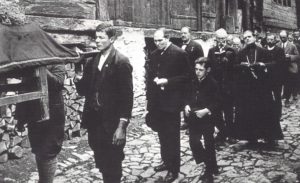 Jacques Feyder’s 1925 drama, about a boy grieving the death of his mother, marked a significant advance over the melodramatic conventions of his time.
Jacques Feyder’s 1925 drama, about a boy grieving the death of his mother, marked a significant advance over the melodramatic conventions of his time.
One can view much of the silent era in movies as a process in which filmmakers gradually unearthed a narrative language appropriate to the new art form. The Belgian-born Jacques Feyder, something of an outsider in the world of French cinema, was one of the first to discard shopworn theatrical affectations, bringing a natural ease and sensitivity to his work that holds up very well today. In his 1925 film Visages D’Enfants (or in English translation, Faces of Children), everything comes together into a satisfying artistic whole.
The picture opens with a funeral—the wife of a village mayor in the Swiss Alps has died suddenly, leaving two children. The little girl is too young to understand what has happened, but her 12-year-old brother Jean (played by Jean Forest), is devastated. The boy faints at the graveside, in a sequence featuring extraordinarily rapid cutting that conveys his overwhelming distress.
Jean puts a portrait of his mother on the wall and prays to it. He faithfully goes to put flowers on her grave every Sunday. Meanwhile, the lonely father decides to get remarried to a local widow, but is afraid to tell his son. He gets a local priest to take the boy on a week-long excursion, during which the priest eventually breaks the news to Jean, on the very day of the wedding. The sense that this is an understandable strategy, yet nevertheless cruel, is subtly conveyed. The entire film, co-written by Feyder and his wife Françoise Rosay, demonstrates an acute interest in psychology that is unusual for its time.
The sudden appearance of a stepmother, who has a daughter of her own about Jean’s age, causes the boy to feel displaced in many little ways. Not allowed to express anger about this event, he vents his hostility on his new stepsister in an escalating little war that leads to a crisis of melodramatic proportions. This crisis, and the ending that follows, is somewhat reminiscent of D.W. Griffith in its combination of suspenseful cross-cutting and extreme emotion. But the film has taken the point of view of a passionate grieving boy throughout, so the resolution is a perfect fit with the subject.
The movie is constructed like a morality play, but without the duality or judgmentalism that one has come to expect from this kind of story. None of the characters—the boy, his stepsister, the parents—are archetypes of either virtue or vice. They do disturbing things, but they are suffering human beings capable of love and deserving of forgiveness. This is a portrait of grief, and its power over the mind of a child, that seeks to understand rather than condemn. Visages d’Enfants does not plod, preach, or overemphasize its themes. It’s a jewel.

